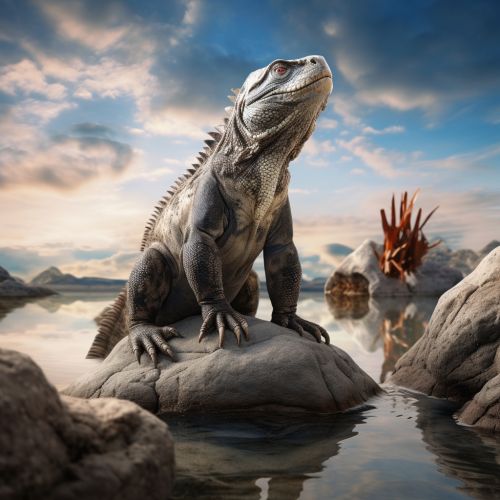Tetrapods
Introduction
Tetrapods are a superclass of animals that includes all species with four limbs (or whose ancestors had four limbs). This group includes amphibians, reptiles, birds, and mammals. Tetrapods evolved from a group of animals known as the elpistostegids around 375 million years ago during the Devonian period, in a development known as the evolution of tetrapods. This marked a significant step in the history of life on Earth, as it enabled animals to move from aquatic to terrestrial environments.


Evolution
The evolution of tetrapods began in the mid-Devonian period as the climate became warmer and the environment more suitable for life on land. The first tetrapods were likely lobe-finned fishes, similar to the modern coelacanth, that evolved legs to move around in shallow water and swampy areas. Over time, these early tetrapods adapted to life on land, leading to the emergence of amphibians, reptiles, birds, and mammals.
From Fish to Tetrapods
The transition from aquatic to terrestrial life required significant anatomical changes. The ancestors of tetrapods evolved robust limbs capable of supporting their body weight on land, as well as lungs for breathing air. The development of digits (fingers and toes) was another crucial adaptation, allowing these early tetrapods to grasp and manipulate objects. This transition is well-documented in the fossil record, notably in the form of Tiktaalik, a 375-million-year-old fossil fish that exhibits characteristics of both fish and tetrapods.
Adaptation to Land
Once on land, tetrapods continued to evolve and diversify, leading to the emergence of various groups. Amphibians were among the first to appear, followed by amniotes, a group that includes reptiles, birds, and mammals. These animals developed the amniotic egg, which allowed them to reproduce on land without returning to water. This was a significant adaptation that contributed to the success of amniotes in terrestrial environments.
Classification
Tetrapods are classified within the clade Tetrapoda, which is part of the larger clade Sarcopterygii, or lobe-finned fishes. The tetrapods are further divided into four major groups: amphibians, reptiles, birds, and mammals. Each of these groups is characterized by unique adaptations and a distinct evolutionary history.
Amphibians
Amphibians, including frogs, toads, salamanders, and newts, are the most basal group of tetrapods. They are characterized by a life cycle that involves both aquatic and terrestrial stages. Most amphibians lay their eggs in water, where they hatch into aquatic larvae that undergo metamorphosis to become terrestrial adults.
Reptiles
Reptiles, including turtles, lizards, snakes, crocodiles, and dinosaurs, are a diverse group of tetrapods that evolved from an amphibian-like ancestor. They are characterized by their scaly skin and the ability to lay hard-shelled eggs on land.
Birds
Birds are a group of endothermic (warm-blooded) tetrapods that evolved from theropod dinosaurs during the Mesozoic Era. They are characterized by their feathers, beaks, and the ability to fly, although not all birds are capable of flight.
Mammals
Mammals are a group of endothermic tetrapods characterized by their hair or fur, the presence of mammary glands in females, and a unique jaw structure. They include a diverse range of animals, from rodents and bats to elephants and whales.
Anatomy and Physiology
The anatomy and physiology of tetrapods vary greatly due to their diverse lifestyles and habitats. However, all tetrapods share certain common features, such as a vertebral column, four limbs with digits, and lungs for breathing air.
Skeleton
The tetrapod skeleton is characterized by a robust vertebral column that supports the body weight on land. The limbs are also highly specialized, with a common pattern of one bone (the humerus or femur), followed by two bones (the radius and ulna or tibia and fibula), then multiple small bones (the carpals or tarsals), and finally the digits.
Respiratory System
All tetrapods possess lungs for breathing air. In amphibians and some reptiles, gas exchange also occurs through the skin, a process known as cutaneous respiration. Birds have a unique respiratory system that includes air sacs, allowing for efficient oxygen exchange during flight.
Reproduction
Tetrapods exhibit a wide range of reproductive strategies. While amphibians typically lay their eggs in water, reptiles, birds, and most mammals lay hard-shelled eggs on land or give birth to live young. Parental care is also common in many tetrapod groups, particularly birds and mammals.
Ecology and Behavior
Tetrapods occupy a wide range of ecological niches and exhibit diverse behaviors. Some are solitary, while others live in complex social groups. Many tetrapods are active during the day (diurnal), while others are active at night (nocturnal). Some tetrapods are herbivores, others are carnivores, and many are omnivores.
Conservation
Many tetrapod species are currently threatened by habitat loss, climate change, and other human activities. Conservation efforts are crucial to protect these species and maintain biodiversity. These efforts include habitat protection, captive breeding programs, and legislation to regulate hunting and trade.
